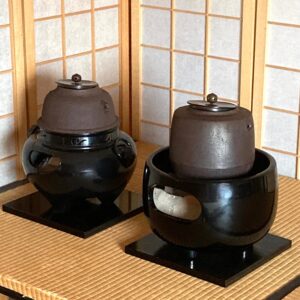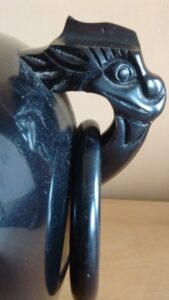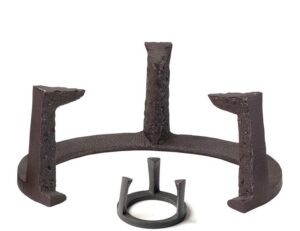Furo and Kama Changes

Ki-men bu-ro, 鬼面風炉, demon-face wind-hearth, Kara-kane, with metal rings held by ‘dragon’ head kan-tsuki, 鐶付, metal ring-attachment, 唐銅, Tang-copper, bronze, with shin-nari kama, 真形釜, true-form kettle, tetsu, 鉄, iron, with ki-men kan-tsuki, 鬼面鐶付, demon-face metal ring-attach, by Kana-mori Jō-ei, 金森浄栄, Gold-woods Pure-splendor, Taka-oka-shi, 高岡市, High-hill-city, To-yama-ken, 富山県, Wealth-mountain-prefecture. Supported on a shin-nuri, 真塗, true-lacquer, shiki-ita, 敷板, spread-board.
Mayu bu-ro, 眉風炉, eyebrow wind-hearth, with oblong hi-mado, 火窓, fire-window, black lacquered ceramic, shin kuro, 真黒, true-black, (this furo is also classified as a do-bu-ro, 土風炉, earth-wind-hearth) by Yama-moto Sō-un, 山本崇雲, Mountain-origin Revere-cloud. Choice of Sen Rikyū. Supported on a shin-nuri, 真塗, true-lacquer, shiki-ita, 敷板, spread-board; the doburo is often placed on an ara-me ita, 荒目板, rough-eye board, with graduated scored grooves, shin-nuri, 真塗, true-lacquer, shiki-ita, 敷板, spread-board. The wooden board protects the tatami from the heat of the fire in the furo.
The pictured mayu buro is shown with a kata-tsuki gama, 肩付き釜, shoulder-thrust kettle, tetsu, 鉄, iron, by Kettle, kama, kettle; tetsu, 鉄, iron, with design of shira-sagi, 白鷺, white-egret, by Taka-hashi Kei-ten, 高橋敬典, High-bridge Respect-rule, Yama-gata, 山形, Mountain-shape. National-treasure, Nin-gen Koku-hō, 人間国宝, Person-space Country-treasure. The kama is supported in the furo on a trivet called a go-toku, 五徳, five-virtues.
From ancient times in Japan, hot water was always at the ready in a kettle, tetsu-bin, 鉄瓶, iron-bottle, with handle and spout set on a gotoku over a wood fire in the large open i-ro-ri, 囲炉裏, enclosed-hearth-inner. The portable hi-bachi, 火鉢, fire-bowl, has been in use in Japan for centuries.
Hot water poured from a ‘tea kettle’ with a spout and handle is known around the world. There may be a question regarding the principal reason why the kama was used in Chanoyu rather than the familiar tetsu-bin. Perhaps the kama was large enough to provide an ample amount of hot water for a large group of people. There are large iron kettles, so large, in fact, that their weight makes them too heavy for ordinary human beings to move. Such pouring kettles were suspended over a fire, and water was ladled out. Water is handled with a hi-shaku, 柄杓, handle-ladle. The kama for Chanoyu has no spout or handle, and is moved with a pair of loose kan, 鐶, metal rings. A relatively small spouted kettle is used in Chanoyu when desired. Set with a charcoal fire, it provided heat and hot water in a tetsubin set on a gotoku. The gotoku, originally, was used in the cooking hearth with the ring up and the three posts in the ashes.
An open furo allows the ash bed, hai-gata, 灰形, ash-form, to be partially revealed. When the charcoal fire is rebuilt, while the kama is removed, the guests are invited to look closely at the ash bed and the charcoal fire in the furo. Therefore, the host takes considerable effort in making the ash bed as attractive as possible. This may be one of the reasons why Rikyū, and others, changed the form of the furo, so that the guests may see the ash bed. The ashes are shaped and smoothed with a variety of hai-saji, 灰匙, ash-spoons. The most familiar form and style of the haigata is ni-mon-ji, 二文字, two-letter-character, that has two ridges parallel to the front of the furo. The form may be likened to waves. For special Tea presentations, the ash bed is shaped and spoonfuls of ash a laid on the nimonji to create uroko-bai, 鱗灰, scale-ash, to evoke dragon scales.
In Buddhism, if one practices the Tripitaka, Hindi ‘three-baskets’, practicing the connecting teaching, thinking to become a Buddha, and after countless ages, one must reduce the body to ashes and enter extinction, and thus destroy oneself, leaving no trace or form behind.

Detail of ki-men kan-tsuki, 鬼面鐶付, demon-face metal ring-attach.
The design of the kimen buro is heavily influenced by Chinese design and concept. The demon motif may be likened to the dragon, tatsu, 龍, which is a Buddhist symbol of enlightenment. The metal rings were for transporting the furo and kama.
The kama has a curved flange hane, 羽, wing, that rests on a koshiki, 甑, ring support, the upright rim of the furo, creating a single unit that identifies it as a kiri-kake bu-ro, 切掛風炉, cut-hang wind-hearth, or kiri-awase, 切合風炉, cut-join wind-hearth. The open furo with uroko-bai evokes the dragon motif of the kimen buro and kama kantsuki.
The Asian dragon brings rain, and thus provides protection against fire. The mayu-buro is at times placed on the arame-ita, 荒目板, rough-eye-board, which has graduated, scored lines that suggest the sea, which enhances the references to the water and dragons.
The mirror-finished lacquered board is derived from Buddhist altar structure. This is due in part to offering tea to the Buddha in Chinese Zen Buddhist temples during the Song dynasty.

The principal differences between the components of the closed kirikake–buro/kama and the open do-buro /kama is the prominence and symbolic significance of the gotoku – trivet and hai-gata – ash bed.
The mayu buro is ceramic, do-bu-ro, 土風炉, earth-wind-hearth, and is a manifestation of the element of Do, tsuchi, 土, Earth. The pictured mayu buro has a kama with the no flange-like hane, 羽, wing. In very formal tea presentations, a shin-nari gama, 真形釜, true-shape kettle, is required. The hane also conceals the seam where the top of the kama is joined to the bottom. Iron kama rust and disintegrate, and some lose the hane, which is called ha-ochi, 羽落, wing-drop. A kama without the hane is designed with a somewhat rough seam implying that it once had a hane, and therefore the kama is regarded as a treasure from the past.
Many of the old furo were tetsu-bu-ro, 鉄風炉, iron-wind-hearth, and subject to rust and deterioration and subsequently, lose the upright collar, koshiki, 甑, that supports the kama. This circumstance lead to the use of a gotoku to support the kama in the furo, which is called a yatsure bu-ro, 窶れ風炉, worn down-wind-hearth. Many of the old furo and kama were much larger than the present furo kama. Large furo modeled after the old yatsure buro have been, and continue to be, made for use in the tenth month; Kan-na-zuki, 神無月, God-no-month. There is an implication that the large old furo was in some way associated with Buddhism, because, in the tenth month, the Shintō gods leave their shrines and gather at Izumo Tai-sha, 出雲大社, Out-cloud Great-shrine, leaving the Buddhist deities in their altars.
The large kama was preserved and used in the ro, the sunken hearth, which was perhaps one of the reasons for the ro to be created. The large, broken down furo was used in the tenth month to reflect the decline and withering nature of autumn. A small kama was, and is, used in the old furo supported on a gotoku. In time, the furo was designed as an open bowl that required the use of gotoku to support the kama, which no longer needed a hane. However, remembering the past, kama with hane continued to be made and used in Tea presentations, and are identified as a shin-nari gama, 真形釜, true-shape kettle.
These changes in the design and structure of the kirikake buro and flanged kama, to the mayu doburo, with a separate support in the gotoku, imply Rikyū’s intention of changing Chanoyu from a Chinese Buddhist ritual, to a manifestation of Japanese art and custom to share Tea with ordinary people. However, the essence of Buddhism was never abandoned in Chanoyu. ‘Cha Zen Ichi Mi’, 茶禅一味, Tea Zen One Taste. Both forms of furo and kama continue to be essential to the presentation of Tea.
When the open furo was used, the kama was supported on the gotoku. Rikyū turned the gotoku over so that the posts were up and the ring was in the ash bed. This held true when the gotoku was used to support the kama in the sunken ro. Rikyū used a small gotoku as a kazari futa-oki, 飾蓋置, display lid-place, to support the lid when removed from the kama.
The gotoku futaoki, when displayed, is placed with the ring down, and the posts upright with one post at the back. When supporting the kama lid, the ring is up, with the ring down and one post forward, according to Rikyū. When the gotoku is used in the furo to support the kama, the gotoku futaoki is not used. As the gotoku is required to support the kama in the ro, the gotoku futaoki is not used, except when the kama is suspended over the ro or when a kama with a wide flange, hane, is placed on wooden blocks, suki-gi, 透木, through-wood, set on the edge of the ro-dan, 炉壇, hearth-foundation, and a gotoku is no longer required. It appears that Rikyū wanted to use a gotoku when presenting Tea.
In Buddhism and other belief systems, there are the Go-toku, 五徳, Five-virtues, which are human attributes that can aid one an enlightened being. Although there are variations, one important grouping is comprised of On Ryō Kyō Ken Jō, 温良恭倹譲, Warmth Kindness Respect Frugality Generosity.
For further study, see also: Furo: Style and Form and Furo to Ro

